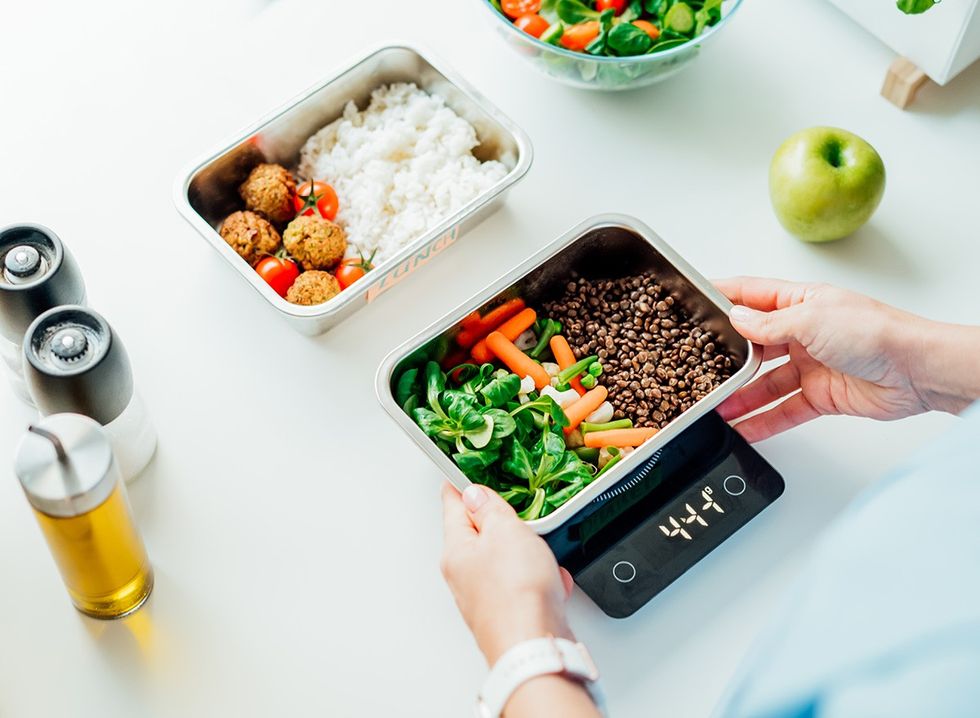You probably already know that amping up your protein intake is one of the best ways to jumpstart weight loss. However, not all protein sources are created equal. JJ Virgin is a triple-board-certified health expert and four-time best-selling author. In a recent YouTube video, she discusses how the latest diet trend of eating protein is one point, but that some people are making a bike mistake. “We're seeing weird stuff coming out in the supermarket. Crazy high protein foods, chips, Poptarts, cookies, ice cream, even mac and cheese, I kid you not. Now I want you to increase your protein,” she says in the viral clip. “But I don't want you to be fooled by high protein, health food posers. So I'm going to uncover some of the worst culprits I found and what you can do instead. “
Avoid: Bolthouse Farms Protein Shakes
Her first “dishonorable mention” is Bolthouse Farms Protein Plus Chocolate Shake. “No, here's the thing: sometimes you just need a quick grab-and-go type of thing. So this kind of looks good. It says protein plus chocolate, 30 grams of protein. Here's what they don't tell you: This is 400 calories, 49 grams of which are sugar and 55 grams of carbs, which is more than a soda. And what do we have for the first ingredients? Milk, water, and cane sugar,” she says.
Try Instead: Less Sugary Protein Shakes
“So what do you do if you are out and you want to grab and go protein drink? Here's a couple that I really like. The one I love is the Koia plant-based protein drink, which is 190 calories and has 18 grams of protein. And then a prebiotic fiber cocoa powder. Way down here is organic cane sugar, and there are only four grams of added sugar and seven grams of fiber. If you're home, use one of my protein shakes from Reignite,” she says.
Avoid: Protein Infused Oatmeal
Her next item to avoid is Kodiak Cakes oatmeal. “This is like putting protein in a cola and thinking it's healthy,” she says about oatmeal, noting that this version is “definitely not heart healthy” even though it says it's protein packed. “This one's got 14 grams of protein, four grams of fiber. So far, it sounds good, except that it's got 12 grams of sugar in it for 230 calories,” she says.
Instead: Make Your Own Oatmeal and Add Protein Powder
Here's what you do instead. “Get your own gluten-free oatmeal. Remember, make sure it's gluten-free. That means it's not been processed in a plant with other things containing gluten. So here I've got old-fashioned rolled oats. You can also get steel-cut oats and all you need to do to pump up the protein is add in some protein powder. You can do plant-based. You can do paleo inspired by my company, Reignite Wellness. And if you want to add a little bit of sweetness, here is an amazing hack you may not know about. It's called RX Sugar. Rx Sugar is allulose, which lowers your blood sugar. This is a great thing to combine with oatmeal, as it might bring your blood sugar up a little bit more than you want. RX Sugar will counteract that and give you that sweet that you want,” she says.
Avoid: Protein Cookies and Granola Bars
Also, be careful with grab-and-go granola bars. “Sometimes it's just really easy to take a bar, put it into your purse or briefcase. I call it emergency food. So you never end up in trouble. So a granola bar here, this Kodiak granola bar, 10 grams of protein, 11 grams of sugar, come on, man. And 26 grams of carbs. 210 calories,” she says. Another to avoid? Complete Cookie. “When you look at the reality of it, it's 480 calories, 16 grams of protein, and wait for it. 22 grams of sugar,” she says.
Instead: Healthier Protein Bars
“Let's trade these out for a way better choice,” she says about her protein bars that are made with allulose, “and allulose is this really cool therapeutic sugar that doesn't raise blood sugar. Insulin doesn't really have any calories and lowers your blood sugar too. So delicious, tastes great.”
Avoid: Greek Yogurt Packed with Sugar
Next on her no-no list is “Greek-style yogurt, super high in protein. So you go to the store, and you go, Ooh, these ones look good. Wow, this is Greek yogurt, caramel sundae, or cookies and cream. Hopefully, before you buy, and you read the label, and you went, whoa, alright, well this is 10 grams of protein, 190 calories and 19 grams of added sugars,” she says.
Instead: Lower Sugar Yogurt
“So what do we do instead? Here are some choices. Number one, if you're plant-based or dairy intolerant, I love this Siggi's plant-based coconut yogurt. They added in some pea protein. So, you get 11 grams of protein in this one, and you only get four grams of added sugar. Or if you're not dairy intolerant, then get yourself some Greek-style yogurt. And if you want to sweeten it up a bit, throw in some RX sugar because this is going to give you the sweet without any of the bad effects. In fact, I try to add allulose into my daily diet because it lowers your blood sugar response to a meal. So it's a great way to get a little sweet and also help your blood sugar balance.”
Avoid: Protein Mac and Cheese
Her last items to avoid are muscle mac, high protein mac, and cheese. “There's just some things that you don't mess with, and I think mac and cheese is just one of those. This one has 400 calories in it, 20 grams of protein, and 63 carbs. So this is just like a bomb in here,” she says.
RELATED: This Plan Is How to Lose 5 Percent Body Fat In 2 Weeks
Instead: Protein Pasta
“If you want some pasta, there's so many great choices out there,” she says. Chickpea or lentil pasta is a great option, “and then add in some grass-fed beef and some marinara sauce for the win before you get overwhelmed.” And if you enjoyed this article, take advantage of these15 Quick Ways to Lose Body Fat Percentage in a Week.















 27. Regular YogurtShutterstock
27. Regular YogurtShutterstock Shutterstock
Shutterstock Shutterstock
Shutterstock A Day of Measured EatingShutterstock
A Day of Measured EatingShutterstock







 I'm a Nutritionist and These 9 High-Protein Snacks Keep My Clients Full While Losing 50 Pounds
I'm a Nutritionist and These 9 High-Protein Snacks Keep My Clients Full While Losing 50 Pounds
 Shutterstock
Shutterstock 2. Processed FoodsShutterstock
2. Processed FoodsShutterstock Shutterstock
Shutterstock Shutterstock/Prostock-studio
Shutterstock/Prostock-studio Shutterstock
Shutterstock Pro TipsShutterstock
Pro TipsShutterstock Shutterstock
Shutterstock Shutterstock
Shutterstock Shutterstock
Shutterstock Shutterstock
Shutterstock Don’t Drink as Much AlcoholShutterstock
Don’t Drink as Much AlcoholShutterstock Most Women on GLP-1s Are Making a Few Common MistakesShutterstock
Most Women on GLP-1s Are Making a Few Common MistakesShutterstock Soda and Sugary DrinksShutterstock
Soda and Sugary DrinksShutterstock Shutterstock
Shutterstock Eat BreakfastShutterstock
Eat BreakfastShutterstock And Improve Insulin SensitivityShutterstock
And Improve Insulin SensitivityShutterstock Belly Flab Strip Tip: Sugar and Fat Calories Leave Its Mark on Your BodyShutterstock
Belly Flab Strip Tip: Sugar and Fat Calories Leave Its Mark on Your BodyShutterstock Shutterstock
Shutterstock The Drugs Mimic the GLP-1 Hormone Naturally Produced by the BodyShutterstock
The Drugs Mimic the GLP-1 Hormone Naturally Produced by the BodyShutterstock 3. Deep-Fried ItemsShutterstock
3. Deep-Fried ItemsShutterstock